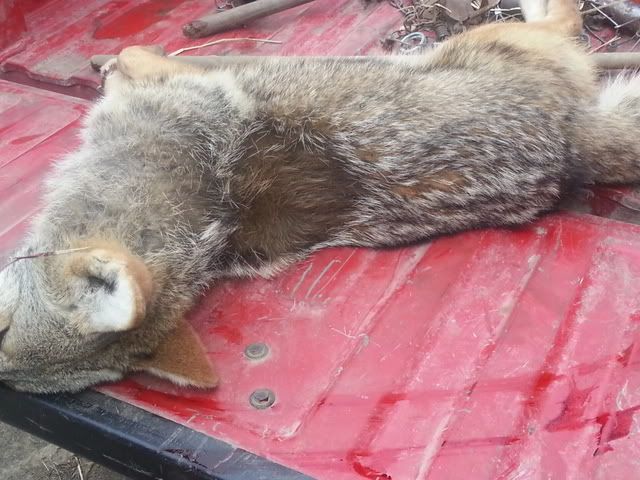|
|
Post by bogio on Dec 28, 2012 18:45:33 GMT -6
Here she is boys. The Brass Ring. The reason I head out everyday. Crisp clean one dollar section III.  |
|
|
|
Post by trappincoyotes39 on Dec 28, 2012 19:03:02 GMT -6
so beautiful it about brings a tear to me eye...........................  |
|
|
|
Post by coloradocat on Dec 28, 2012 22:19:41 GMT -6
You petted the hair off of it already.
|
|
|
|
Post by Possum on Dec 29, 2012 7:33:29 GMT -6
They say most coyotes are used in the trim trade. You got one that is pre-trimmed. Good deal....
|
|
|
|
Post by redeagle on Dec 29, 2012 14:30:24 GMT -6
Too bad it's mangy.
|
|
|
|
Post by trappnman on Dec 30, 2012 7:53:52 GMT -6
I don't think thats mangy redeagle- but I could be wrong
to me it just looks like a rubbed/shedding coyote.
thats what prevents me from doing any snaring this time of year- seems they breakdown so quick- just not fair!
|
|
|
|
Post by Possum on Dec 30, 2012 8:21:22 GMT -6
I agree, it's not mange. I always wondered about the cause. My guess is it's where they scratch fleas and burrs out with their back feet. I've caught coyotes with pretty good rubs even in early November, but from this time on, it will become increasingly common. By end of January about 1/2 are pretty well used up.
Another theory I have is when they curl up to sleep, those hairs over their shoulders stand up and become frosted. Then when they wake up and shake, the frosty hairs break off. I got that idea once when I came up to a sleeping coyote in a trap and it was covered with fresh snow. I thought it was dead until it woke up.
|
|
|
|
Post by trappnman on Dec 30, 2012 8:27:32 GMT -6
I was going to start another thread on this, but I'll continue here-
those rubs piss me off! they are what, 1% of the fur, but when you sell its like the whole pelt is worthless. and I suppose in a way, it does show deterioration of the pelt (for example in coon, on redneck spring coon the color isn't whats low grade, as it is the window of the condition of the fur- spring mink would be the same) to a degree, but come on!
like Possum said, I get a few even in late oct, nov- but this time of year, it seems like its prevelant.
my question is, what do coyotes start getting bad due to rubs/shedding in your area. When I went to KS in late jan, the ones I got were perfect- was I just lucky, or does it vary that much from region to region?
Cause here, every time I've tried a little jan trapping.snaring the rub % was 1/3 to 1/2 starting about now.
|
|
|
|
Post by bogio on Dec 30, 2012 9:17:27 GMT -6
Tman and Possum,
You fellas are correct, it is rub damage, not mange. Most I get are confined to the shoulder region, this particular one is also rubbed on the flank on the side that is not showing. I am lucky in that I've only had one other bad one like this this year although it wasn't to quite this degree. It was also a red one and was from the same location. I've had a couple with small rubs at the point of the V in the mane and one lousy one but all in all it has been a good year. I think a lot of this kind of damage is caused by cockle burrs getting matted in and pulled out. I remove ALOT of burrs from my coyotes.
I finished and sent several of these to NAFA last year. My reasoning was that although the shoulders were junk the rear half of the pelt was generally problem free. Nafa graders didn't see it that way. They all went into Sec. III and they all brought ONE DOLLAR each. I won't be sending any of them this year.
Although you do see more of this as the season gets later, I'll continue on till the close as the "Pickup Enthusiasts" won't stop and I'm not going to let them have all the fun.
|
|
|
|
Post by trappnman on Dec 30, 2012 9:34:10 GMT -6
I finished and sent several of these to NAFA last year. My reasoning was that although the shoulders were junk the rear half of the pelt was generally problem free. Nafa graders didn't see it that way. They all went into Sec. III and they all brought ONE DOLLAR each. I won't be sending any of them this year.
thanks for answering that- I've wondered the same.
|
|
|
|
Post by kellogg on Dec 30, 2012 12:38:51 GMT -6
This is the worst one so far this year. This was just after Thanksgiving this year If I remember right.  |
|
|
|
Post by bogio on Dec 30, 2012 13:00:54 GMT -6
$1
|
|
TRay
Demoman...
  
Posts: 107
|
Post by TRay on Dec 30, 2012 14:35:50 GMT -6
50% of our coyotes have that here, we call them neckers. At one time I thought it was mange but have been told by vets that it is caused by a mite that lives in the skin. We see it year round in the coyotes, and if one member of the family has it they all will.
|
|
|
|
Post by trappincoyotes39 on Dec 30, 2012 21:11:58 GMT -6
I always referred to them as lice, but sure there is more of a correct term. Not a true rub though for sure.
OK I think I found it here is some reading:
T riclmdectes eanis:severe pedieulosis in coyotesPEDICULOSIS is caused by an infestation of lice of theorder Mallophaga (biting lice) or of the order Anoplura(sucking lice). It can be easily diagnosed by findingadult lice or nits in the hair. In severe infestations ofbiting lice, alopecia or matting of hair may be present.The biting louse Trichodectes canis is commonly iso-lated as a cause of pediculosis in dogs;““ however,reports of T. canis in coyotes are few.” Cases of T.canis in dogs have become less prevalent during the pasttwo decades, probably through routine use of insecti-cides on dogs and around kennels.In many instances, pediculosis may initially be con-fused with mange unless the causative agents are iden-tified. In most instances in wild Canidae (i.e., Wolves,coyotes, foxes), alopecia caused by infestations of lice isprobably attributed to mange.In this paper we describe two cases of severe alo-pecia associated with large numbers of T. canis incoyotes (Canis latrans).Case N0. 1On December 7, I976, a trapper killed an adultfemale coyote. Because of alopecia the coyote wasbelieved to have mange and was submitted to a class inwildlife disease at Washington State University.Matted hair was noted over the shoulders, the dorsalthorax, and the dorsal and lateral portions of the neck(Figure 1). The underfur was separated from the skinand was retained within the midshaft of the guardhairs. Approximately 35% of the coyote’s body surfacewas involved. In many areas, the coat was noticeablysparse. Mature and immature lice and nits could be seenon the hairs (Figures 2-4). (Continued on next page)VETERINARY MEDICINE I SMALL ANIMAL CLINICIANWilliam J. Foreyt. PhDG.G. Long. DVMVeterinary Microbiology & PathologyWashington State UniversityPullman, Washington 99164N.L. Gates, DVMU.S. Department of AgricultureAgricultural Research ServiceDubois, Idaho 83843Figure 1Coyote with heavy infestationof Trichodectes canis exhibitingmatted coat over the thorax,shoulders, and neck.April 1978/ 5 0 3 Q.
--------------------------------------------------------------------------------
Page 2
Figure 2Coat from thecoyote in Figure 1.The undercoat hasseparated from the skinand is matted withinthe guard hairs.Figure 3Numerous Tr/'ch0~dectes canisand nits onthe hairs.Ciose-up of Iiceand nits in an areaover the shouldersof the coyote.VETERINARY MEDICINE / SMALL ANIMAL CLINICIAN5C4 / April 1978
--------------------------------------------------------------------------------
Page 3
/ TRICHODECTES CANIS (CONT’D)The lice were collected, fixed in 70% alcohol,cleared in 5% KOH, and examined microscopically. Tri-chodectes canis was the only ectoparasite detected(Figure 5). The identification was confirmed by Dr. ].Kierans of the Rocky Mountain Laboratory, Hamilton,Montana. The number of lice on the animal wasestimated to be 50,000.Variable acanthosis, diffuse hyperkeratosis, andfocal parakeratosis were seen when the skin was ex-amined microscopically. Superficial portions of the hairfollicles were filled with keratinous debris. Many of thehair follicles were active. Sebaceous and apocrineglands were mildly hypertrophied. Inflammatorycellular infiltrate was superficial and consisted primari-ly of neutrophils in the epidermis and papillary debris.The superficial keratinous debris harbored manybacteria.Case N0. 2On December 2, 1976, five days before Case No. lwas seen, a coyote which had been caught in the wildand confined at the United States Sheep ExperimentStation, Dubois, Idaho, was found to have lesionssimilar to those seen in Case No. l. When the animal’sskin was examined, T. canis was the only ectoparasitedetected. Although the infestation was heavy, thenumber of lice present was not estimated.The insecticide, Diazinon, as a 50% wettable pow-der, was dusted on the bedding in the coyote’s den boxthe day after the infestation was noted. No lice weresubsequently found on this coyote or coyotes in adjoin-ing pens. Within six weeks, new growth had replacedthe affected fur.5DiscussionReports of mange in wild Canidae are often based solelyon observations of alopecia or matted hair.“ Suchreports should be viewed with some skepticism since thecausative agent must be identified before a diagnosiscan be confirmed. In both cases reported here, mangewas initially suspected (Demodex, Sarcoptes, Otodectesspp.), but T. canis was the etiologic agent.Infections of T. canis may be a minor hazard toVETERINARY MEDICINE / SMALL ANIMAL CLINICIANhuman health. They can serve as intermediate hosts forthe dog tapeworm Dipylidium caninum,1'“'9 which candevelop to the mature form in man. Anyone who hascontact with wild Canidae should be aware that infec-tive cysticercoids can be transferred from lice to man byaccidental hand-to-mouth contact, with resultant inges-tion of the cysticercoids.ACKNOWLEDGMENTThe authors thank Mr. Al Forar for taking the photographs.REFERENCESl. Dement, W.M.: Pedieulosis of the Canine. Southeast. Vet. 16:27-31; 1965.2. Georgi, ].R.: Parasitology for Veterinarians, 2nd ed. W.B. Saunders Co.,Philadelphia, Pa., 1974.3. James, T.].; Harwood, R.F.: Herm's Medical Entomology, 6th ed. Mac-Millan Co., Toronto, Canada, 1969.4. Ameel, D.].: Parasites of the Coyote in Kansas. Trans. Kan. Acad. Sci.58:208-210; 1955.5. Eads, R.B.: Ectoparasites from a Series of Texas Coyotes. I. Mammal.29:268-271; 1948.6. Emerson, K.D.: Checklist of the Mallophaga of North American (North ofMexico) III, Mammal Host List. Deseret Test Center, Dugway, Utah, 1972.7. Hopkins, C.H.E.: The Host Associations of the Lice of Mammals. Proc. Z001.Soc. London 119:387—604; 1949.8. Trainer, D.O.; Hale, ].F.: Sarcoptic Mange in Red Foxes and Coyotes ofWisconsin. Bull. Wildl. Dis. 5:387-391; 1969.9. Moore, D.V.: A Review of Human Infections with the Common DogTapeworm, Dipylidium cariinum, in the United States. Southwest. Vet.l5:283-288; 1962.Figure 5- Trichodectes can/s from the coyote.April 1978/ 505
|
|
|
|
Post by bogio on Dec 30, 2012 22:14:10 GMT -6
The animals I assume to have lice differ quite a bit in appearance to the one I have pictured. They at first glance appear to have extremely heavy fur which upon examination is matted and greasy feeling. They also have an unpleasant "dirty feet" kind of smell. If you kill them and hang them up there will be what looks like sand accumulate on the floor under them, a close look shows it to be little bugs which will also be seen hanging out on the ends of the guard hairs preparing to jump ship. If you lay them on the concrete, in addition to the bugs there will be a wet spot on the floor where they evidently seep.
|
|
|
|
Post by Possum on Dec 31, 2012 6:30:42 GMT -6
That alopecia stuff caused by lice sounds like bad stuff. I did catch a coyote earlier this year that had wooly mats and was real stink-hound. To me the indepth description from Iowa sounds spot on for what that coyote had and it was completely different than the "rubs" or neckers commonly caught. For the most part, the rubbed animals seem to be as clean as the non rubbed. I've skinned out dozens of them over the years and don't ever recall having fleas, lice, nits or anything else on them or jumping off them.
I catch lots of cockle bur infested coyotes but I don't remember ever getting a burr-dog that was also badly rubbed. At lease I never had a badly burred up coyote with a rub that made me think the rubbed neck was mostly attributable to burrs.
I do think it's self-inflicted. I've seen enough dogs sit down, sniff their butt and then scratch their shoulders with their back foot for no apparent reason other than why I scratch my nuts occasionally just because it feels good. Maybe it's just a nervous twitch sort of thing.
|
|
|
|
Post by trappnman on Dec 31, 2012 8:14:34 GMT -6
ditto on what bogio said regarding lice
on similar coyotes as the one kellog pictured, I never felt it was lice, but a scratching at that neck area
as far as burrs- I agree with possum that the ones covered with burrs, are seldom rubbed and the rubbed ones, are realatively free of burrs-
but I do think its burr relled- one gets a mat of burrs in the underfu, and eventually it looks like the above
I think most burrs are pulled out before theyet to that point
|
|
|
|
Post by bogio on Dec 31, 2012 21:38:16 GMT -6
Your "fur" ever get that rubbed look Possum?  |
|
|
|
Post by Possum on Jan 1, 2013 3:12:26 GMT -6
My coyotes do occasionally, ever since I was a teenager, my fur-down-under has been constantly rubbed. Sadly, mostly self-inflicted.
|
|
|
|
Post by northof50 on Jan 5, 2013 18:03:26 GMT -6
|
|